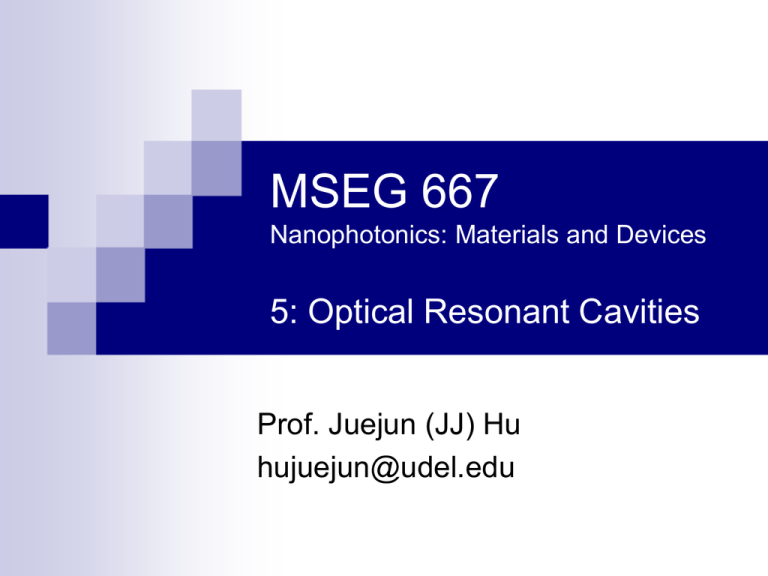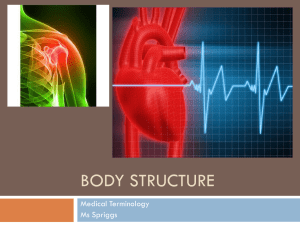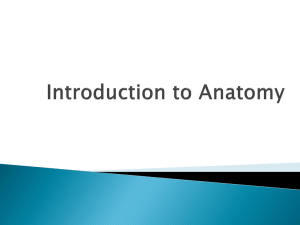MSEG 667 5: Optical Resonant Cavities Prof. Juejun (JJ) Hu
advertisement

MSEG 667 Nanophotonics: Materials and Devices 5: Optical Resonant Cavities Prof. Juejun (JJ) Hu hujuejun@udel.edu Optical resonance and resonant cavities Optical resonant mode A time-invariant, stable electromagnetic field pattern (complex amplitude): an eigen-solution to the Maxwell equations Discretized resonant frequencies (eigen-values), i.e. these modes appear only at particular frequencies/wavelengths The modal fields are usually spatially confined in a finite domain Optical resonant cavities (resonators) Devices that support optical resonant modes Guided mode resonance, surface plasmon (polariton) resonance, and spoof surface plasmon resonance all refer to coupling to propagating modes, even though the same term “resonance” is referenced! Resonance: a mechanical analog The resonance frequency of a string determines the pitch of sound it produces An “infinite corridor” in two mirrors Electromagnetic waves between two perfect conductors (perfect mirrors) Photon Interference between backand-forth reflected light Standing wave formation A simple mathematical model t 1 , r1 Field amplitude: 1 t2, r2 a1 a2 … … an 1 a1 t1 exp ikL L t2 2 a2 a1 r r r2 r1 exp 2ikL L an a1 r n 1 α = 2pK/λ, L Transmission coefficient Ttot atot 2 a 1 1 r 2 n atot a1 ai 1 r i 1 when |r| < 1 Ray tracing: summation of field amplitude, taking into account interference effect (the phase term) A close inspection of phasor summation… Transmission coefficient Phasor Ttot atot 2 a 1 1 r 2 when |r| < 1 r r1 r2 exp L exp 2ikL Eq. (1) A vector on the complex plane with a modulus/length ≤1 Firstly let’s look at a lossless cavity, i.e. α = 0, r1 = r2 = 1, and thus |r| = 1. When kL ≠ Np, the vectors have different directions… When kL = Np, the vectors are aligned (resonant condition). Finite, non-vanishing transmitted intensity ONLY at resonance Transmission spectra Ttot Free Spectral Range FSR = pc/L ω Peak FWHM = 0 A close inspection of phasor summation… Transmission coefficient Phasor Ttot atot 2 a 1 1 r 2 when |r| < 1 r r1 r2 exp L exp 2ikL Eq. (1) A vector on the complex plane with a modulus/length ≤1 When there is loss in the cavity, |r| < 1, and Eq. (1) holds The transmission spectra have non-vanishing values even when the resonant condition is not met! Quality factor Q: Cavity finesse: L r Q 0 0 c (1 r ) 0.5 Transmission spectra Ttot Free Spectral Range FSR = pc/L FSR p r F 1 r 0 .5 ω FSR: Free Spectral Range, peak separation ω0 : resonant (angular) frequency Δω : peak FWHM (Full Width at Half Maximum) Peak FWHM ≠ 0! Extinction ratio: 10·log10(Tmax/Tmin) Standing wave modes in F-P cavities x t 1 , r1 y t 2 , r2 z 1 EL R ,1 z t1 exp ikz z 2 1 ER L ,1 z t1r2 exp 2ikL L exp ikz z 2 ELR,n z r n1 ELR,1 z … ERL,n z r n1 ERL,1 z α = 2pK/λ, L r r1 r2 exp L exp 2ikL Cavity field: Etot z EL R ,1 z ER L ,1 z EL R ,2 z ER L ,2 z ... 1 EL R ,1 z ER L ,1 z 1 r Standing wave modes in F-P cavities (cont’d) N=1 N=2 N=3 N=4 N=5 … Important concepts Quality factor (Q-factor) Q FSR 2 ~ Q 2 ng L Include the factor 2 for travelling wave cavities Free spectral range (FSR, frequency domain) 2 p c0 FSR ng L W : Energy stored in the cavity in J Ploss : Power loss in J/s or W FWHM should be calculated in the linear scale Finesse F 0 W 0 Ploss Include the factor 2 for travelling wave cavities Reference: Juejun Hu, Ph.D. thesis, Appendix I Optical loss in cavities Round trip loss in an F-P cavity 1 r 1 r12 r22 exp 2 L ~ 1 r12 r22 2 L 2 Coupling loss (mirror loss): 1 r12 r2 2 Internal loss (distributed loss): 2 L Non-unity mirror reflectance Independent of cavity length Absorption/scattering of light in the cavity Loss proportional to cavity length L Both Q and finesse scales inversely with cavity loss If distributed loss dominates, Q is independent of cavity length If coupling loss dominates, F is independent of cavity length Cavity perturbation theory Resonant frequency shift due to perturbation Material perturbation e 0 0 2 e r E r 3 2 2 3 Sharp perturbation e e e d r O e e r E r d r 2 e S. Johnson et al., ”Perturbation theory for Maxwell’s equations with shifting material boundaries,” Phys. Rev. E 65, 066611 (2002). The frequency shift scales with field intensity Standing wave vs. travelling wave cavities Standing wave resonators PhC cavities/Fabry-Perot (FP) cavity Light forms a standing wave inside the cavity Traveling wave resonators Micro-ring/disk/racetrack resonators, microspheres Light circulates inside the resonant cavity 2-d PhC cavity (top-view) Micro-ring F-P cavity Microsphere attached to a fiber end Micro-disk Standing wave vs. travelling wave cavities Standing wave resonators PhC cavities/Fabry-Perot (FP) cavity Light forms a standing wave inside the cavity 2-d PhC cavity (top-view) F-P cavity Traveling wave resonators Micro-ring/disk/racetrack resonators, microspheres Light circulates inside the resonant cavity Whispering gallery mode Acoustics Sound wave Optics CW mode Standing wave vs. travelling wave cavities Standing wave resonators Light forms a standing wave inside the cavity Traveling wave resonators Light circulates inside the resonant cavity Ecos 2 E0 cos kz z Ez E0 exp ikz z Esin 2 E0 sin kz z Ez E0 exp ikz z Ecos 1 1 1 Ez E E 1 1 2 z sin z + z = Azimuthally symmetric travelling wave cavities support CW & CCW travelling wave modes as well as standing wave modes; and they are all degenerate (i.e. same resonant frequency) z Degeneracy lifting in travelling wave cavities Antisymmetric mode Breaking the cavity azimuthal symmetry leads to resonance frequency splitting of standing wave modes Symmetric mode Nat. Photonics 4, 46 (2010). APL 97, 051102 (2010). IEEE JSTQE 12, 52 (2006). PNAS 107, 22407 (2010). Optical coupling to cavity modes Coupling approaches Free space coupling: F-P cavity Waveguide/fiber coupling: traveling wave cavities, PhC cavities Phase matching condition: efficient coupling External Q-factor Energy loss due to coupling: Qex 1 1 1 1 Qtot Q Qin Qex Extinction ratio depends on coupling Critical coupling J. Hu et al., Opt. Lett. 33, 2500-2502 (2008). Optical coupling to cavity modes Coupling approaches Free space coupling: F-P cavity Waveguide/fiber coupling: traveling wave cavities, PhC cavities Phase matching condition: efficient coupling External Q-factor Energy loss due to coupling: Qex 1 1 1 1 Qtot Q Qin Qex Extinction ratio depends on coupling Transmission (dB) Increase coupling strength Critical coupling Wavelength (μm) Critical coupling thru = 0 input Critical coupling Complete power transfer: Pthru = 0 Occurs when Qex = Qin Maximum field enhancement inside the resonator Under coupling Qex > Qin Over coupling Qex < Qin Matrix representation of directional couplers b1 b2 a2 a1 a1 Linear, lossless, unidirectional, reciprocal, single-mode couplers a2 a1 a2 Matrix K1 Matrix K2 Coupler 1 Coupler 2 Lossless coupler b2 b1 a1 b1 t b2 * t * a2 2 2 where t 1 Matrix Kn … Coupler n b1 Cascadability: b2 b K1K 2 ...K n a Ch. 4, Photonics: Optical Electronics in Modern Communications, A. Yariv and P. Yeh Coupling matrix approach for travelling wave cavities a2 Transmission 1 b2 Lossless coupler 5 mm a1 0.8 0.6 0.4 0.2 0 b1 1546 1548 1550 1552 1554 Wavelength (nm) α : waveguide loss; β : propagation constant; L : round-trip length a1 b1 t b2 * t * a2 1 a2 b2 exp i L L 2 A. Yariv, Electron. Lett. 36, 321-322 (2000). A2 t 2 A t cos L 2 b1 2 1 A2 t 2 A t cos L 2 1 L 2 where A exp a1 2 Coupling matrix approach for travelling wave cavities a15 3rd order adddrop filters Coupler 4 a13 a16 a14 L6, 6 a11 L5, 5 a12 Coupler 3 L4, 4 Coupled resonator steady state solution: 2 equations for each coupler: 8 total 1 equation for each ring section: 6 total 2 known inputs: a1, a16 Compile the equation coefficients into a 14-by-14 matrix Solve the set of linear equations a9 a10 a7 a8 Coupler 2 a5 L3, 3 a6 L2, 2 L1, 1 a3 a1 Coupler 1 a4 a2 The algorithm can be automated to solve coupled cavities of arbitrary topology The versatile optical resonator Selective spectral transmission/reflection Coherent optical feedback Lasers Increased optical path (interaction) length Optical filters for WDM Spectroscopy and sensing Modulators and switches Slow light: coupled resonator optical waveguide (CROW) Cavity-enhanced photodetector Enhanced field amplitude (photon LDOS) Nonlinear optics Cavity quantum-electrodynamics (QED) Cavity optomechanics Wavelength Division Multiplexing (WDM) Better use of existing fiber bandwidth Little cross-talk between channels Transparent to data format and rate Mature technology See what the “FiOS boy” says about WDM! Wavelength Division Multiplexing (WDM) Multiplexing De-multiplexing λ1 λ2 λ3 … Better use of existing fiber bandwidth Little cross-talk between channels Transparent to data format and rate Mature technology Ring resonator add-drop filter λ1 λ2 • • • λn λ1 λ2 λn … Add-drop filter design rules: • Low insertion loss: critical coupling, low WG loss • Low cross-talk: large extinction ratio, FSR >> channel spacing • Flat response in the pass band • B. Little et al., J. Lightwave Technol. 15, 998 (1997). • B. Little et al., IEEE PTL 16, 2263 (2004). • T. Barwicz et al., JLT 24, 2207 (2006). • F. Xia et al., Opt. Express 15, 11934 (2007). • P. Dong et al., Opt. Express 18, 23784 (2010). Semiconductor lasers AlGaAs-GaAs-AlGaAs double heterojunction lasers n-type AlGaAs GaAs Laser output p-type AlGaAs + mirror mirror Edge-emitting laser Vertical Cavity Surface Emitting Lasers (VCSELs) On-wafer testing Single longitudinal mode operation Low threshold current Long lifetime http://www.rp-photonics.com/vertical_cavity_surface_emitting_lasers.html External Cavity Lasers and VECSELs Wide wavelength tuning range, single longitudinal mode operation Vertical External-cavity Surface-emitting Lasers (VECSELs) Rev. Sci. Instrum. 72, 4477 (2001). http://www.rp-photonics.com/external_cavity_diode_lasers.html The strong photon-matter interaction in integrated high-Q optical resonators make them ideal for sensing Detection of refractive index change induced by surface binding of biological molecular species: proteins, nucleic acids, virus particles WGM resonance Specific surface binding High Q-factor leads to superior spectral resolution and improved sensitivity Cavity-enhanced IR spectroscopy achieves high sensitivity and small footprint simultaneously Single-pass spectrophotometer Source Receiver Cavity-enhanced spectroscopy Extinction ratio change due to presence of absorption Optical path length: L Lambert-beer’s law: I % 1 exp( L) L Sensitivity Footprint Analyst 135, 133-139 (2010). Silicon micro-ring switch/modulator Refractive index change in silicon via free carrier dispersion effect: optical/electrical carrier injection Low power consumption due to small footprint V. Almeida et al., “All-optical control of light on a silicon chip,” Nature 431, 1081 (2004). Q. Xu et al., “Micrometer-scale silicon electro-optic modulator,” Nature, 435, 325 (2005). The challenges: narrow band operation & fabrication/thermal sensitivity 2000 GHz Q = 1,000 Si waveguide cross-section 450 nm × 200 nm









